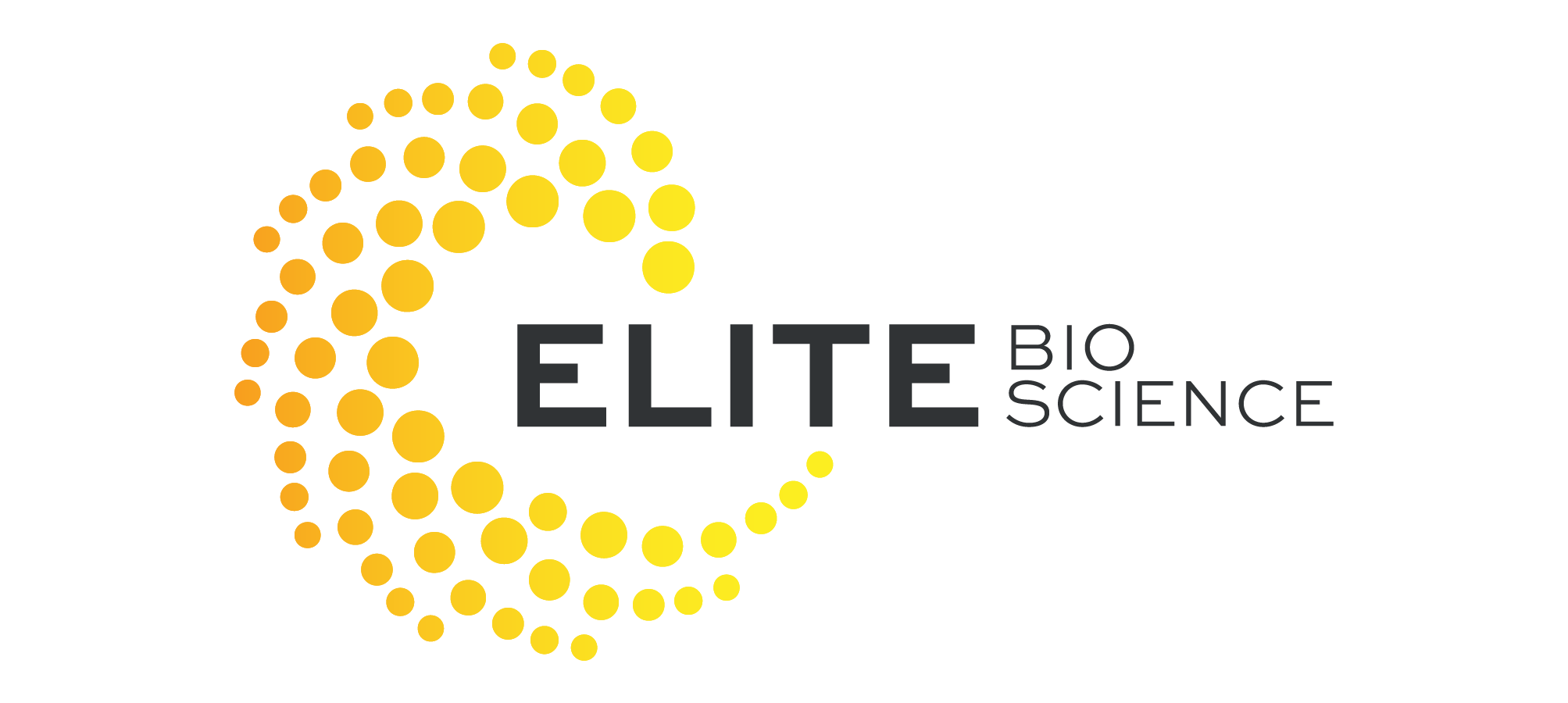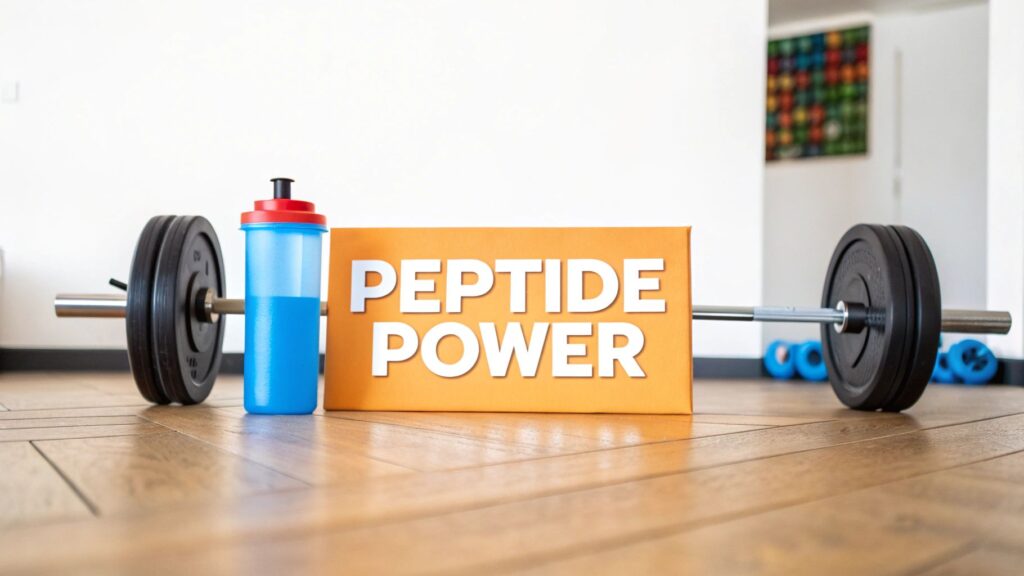When you're looking for the best peptides to help with fat loss and muscle gain, you're really searching for highly specific messengers that can tell your body to ramp up growth hormone, burn through fat stores, and hold onto precious lean muscle. Some of the most effective and popular choices are combinations like CJC-1295 with Ipamorelin, a powerhouse duo for total body recomposition, or targeted compounds like Tesamorelin, known for its ability to go after stubborn visceral fat.
These peptides don't work by brute force; they act as precise signals that optimize the powerful metabolic machinery you already have.
How Peptides Signal Your Body to Build Muscle and Burn Fat

Think of your body as a sophisticated orchestra. For it to play in harmony, the conductor—your endocrine system—sends out specific instructions to each section. Peptides are like the sheet music for individual instruments, delivering clear, direct commands.
One peptide might signal the percussion section (your metabolism) to start burning stored fat for energy. At the same time, another tells the string section (your muscle tissue) to repair and rebuild stronger after a workout. This is their magic: they are short chains of amino acids that function as these vital biological messengers.
This targeted signaling is what makes peptides such a compelling tool for changing your body composition. Unlike generic supplements with broad, often unpredictable effects, peptides can trigger very specific physiological responses. This precision allows you to lose fat while gaining—or at least preserving—lean muscle, a notoriously tricky balancing act to pull off.
Natural vs. Synthetic Peptides
Your body is a natural peptide factory, constantly producing hundreds of different types to manage everything from your immune response to hormone levels. For example, your brain produces a natural peptide called growth hormone-releasing hormone (GHRH), which tells your pituitary gland it's time to release growth hormone.
The peptides used for fitness and wellness are synthetic, meaning they are created in a lab. They're designed to either perfectly mimic your body's natural messengers or, in some cases, improve upon them. Scientists can engineer them to be more stable, last longer in your system, or bind more tightly to their intended cellular receptors, making them incredibly potent tools for guiding specific outcomes.
By introducing these specialized synthetic peptides, you can amplify the body's natural signals for muscle repair and fat breakdown, pushing past the normal limits—especially when you’re in a calorie deficit.
The Key Pathways for Body Recomposition
When you're trying to find the best peptides for fat loss and muscle gain, it helps to know how they get the job done. Most of them work through a few primary channels to reshape your physique:
- Stimulating Growth Hormone (GH) Release: Peptides like CJC-1295 and Ipamorelin are famous for encouraging your body to produce more of its own growth hormone. This is a huge win, as GH is a master hormone for both incinerating fat and building new muscle.
- Improving Metabolic Efficiency: Some peptides help your body become smarter about how it uses fuel. They can direct nutrients toward muscle cells for repair and away from being stored as fat.
- Controlling Appetite: Others can directly influence the hunger signals sent from your gut to your brain, making it far easier to stick to a nutrition plan without feeling like you're constantly fighting cravings.
This multi-pronged attack is why a well-designed peptide protocol can be so effective. Peptides aren't a magic pill, but they can act as a powerful catalyst, seriously amplifying the results you get from your hard work in the gym and kitchen.
If you're ready for a deeper dive into their role in fitness, you can learn more about what peptides are in bodybuilding in our comprehensive guide.
Why Collagen Is a Foundational Peptide for Muscle Growth

When you hear "collagen," you probably think of smoother skin, stronger hair, and healthier nails. And you’re right—it’s fantastic for those things. But its powerful role in building a leaner, stronger physique often gets completely overlooked. Collagen peptides aren't just for aesthetics; they are a fundamental tool for anyone serious about improving their body composition.
Think of building muscle like constructing a brick wall. Most protein powders, like whey, give you the "bricks"—the essential amino acids needed for size and strength. Collagen, on the other hand, is the "mortar." It's the structural protein that holds everything together, forming the critical connective tissue matrix within and around your muscles.
This matrix is absolutely essential for muscle function, transmitting force, and recovering from tough workouts. Without strong connective tissue, your muscles can't perform at their peak, and your injury risk skyrockets, putting a hard stop to your progress.
The Building Blocks of Recovery
Collagen’s real power lies in its unique amino acid profile, which is packed with glycine, proline, and hydroxyproline. These specific amino acids are the raw materials your body needs to synthesize new collagen, directly supporting the repair and reinforcement of tendons, ligaments, and the intramuscular connective tissue that takes a beating during resistance training.
After a hard session in the gym, your body is desperate for these building blocks. It needs them not only to mend muscle fibers but also to strengthen the entire musculoskeletal structure. This comprehensive recovery is the key to building durable, functional strength and is a core reason why collagen is one of the best peptides for fat loss and muscle gain.
A strong musculoskeletal framework is the bedrock of performance. By reinforcing connective tissues, collagen allows you to train harder and more consistently, which is the ultimate driver of muscle growth and fat loss over time.
Research backs this up consistently. Across diverse populations, studies have shown that combining collagen peptides with resistance training for 8 to 12 weeks leads to a significant increase in fat-free mass compared to placebo groups. This has been observed in young men, elderly men battling muscle loss, and premenopausal women, highlighting its broad effectiveness.
More Than Just Support
Beyond its structural role, collagen directly contributes to muscle mass in other ways. For instance, the amino acid glycine is a key player in your body’s natural production of creatine—a compound famous for boosting strength, power output, and muscle growth.
This dual-action benefit makes collagen peptides an indispensable part of any smart fitness strategy. They don't just protect your body from the rigors of training; they actively supply components that fuel muscle synthesis and enhance performance. While women often seek it out for skin benefits, its role in building lean mass is equally important, which is why many now incorporate specific collagen supplements for women into their fitness regimens.
By integrating collagen into your daily routine, you’re giving your body the essential materials it needs to build a resilient and powerful physique from the inside out.
Using GLP-1 Agonists for Powerful Fat Loss
Beyond peptides that directly stimulate growth hormone, another class has absolutely exploded onto the scene for fat loss: GLP-1 receptor agonists. You’ve probably heard of them—compounds like semaglutide and liraglutide. While they were originally created to help manage diabetes, their powerful effect on weight loss has made them some of the most sought-after peptides today.
Unlike growth hormone secretagogues, these peptides don’t send signals for muscle growth. Instead, they work by mimicking a natural hormone your body already makes called glucagon-like peptide-1. Think of GLP-1 as your body’s built-in appetite moderator. After a meal, your gut releases this hormone to tell your brain you’re getting full, slow down how fast your stomach empties, and keep your blood sugar in check.
GLP-1 agonists take that natural "I'm satisfied" signal and turn up the volume. By activating the same receptors, they make you feel fuller for much longer, even on smaller amounts of food. This intense appetite suppression is a total game-changer for sticking to a calorie deficit—the absolute cornerstone of any fat loss strategy.
The Catch: Muscle Preservation Is Key
While GLP-1 agonists are incredibly effective for helping the pounds melt away, there's a huge catch: they don't distinguish between fat and muscle. When you're eating significantly fewer calories, your body can start breaking down your hard-earned muscle tissue for energy. This is a bad trade, as it can tank your metabolism and leave you with a weaker physique.
This is exactly why pairing GLP-1 therapy with consistent resistance training isn’t just a good idea—it's essential. Lifting weights sends an unmistakable signal to your body: "Hey, we need this muscle!" This encourages it to preserve, and even build, lean mass while the peptide helps you tap into your fat stores for fuel. It’s this one-two punch that ensures the weight you're losing is actually fat, leading to a leaner, stronger, and healthier body.
The goal is never just weight loss; it's fat loss. Protecting your lean muscle mass during a cutting phase is the single most important factor for achieving a toned physique and maintaining a healthy metabolism long-term.
Evidence for a Combined Approach
Recent studies have shown just how powerful this dual approach is. When GLP-1 therapy was combined with resistance training, participants saw an average sustained weight loss of around 5.6 kg and a 2.3% drop in body fat percentage—results that were better than using the GLP-1 alone. Even better, this strategy helped minimize weight regain by about 6 kg after the treatment ended. You can read more about these findings on peptide therapy and exercise.
This infographic gives you a quick look at how other popular peptides stack up for hitting specific body recomposition goals.

To make sense of the different options, it helps to see them side-by-side. This table breaks down the main players by how they work and what they’re best for.
Comparing Popular Peptides for Body Recomposition
| Peptide Class | Primary Mechanism | Main Benefit | Key Consideration |
|---|---|---|---|
| GHRH Analogues | Stimulate the pituitary to release growth hormone. | Muscle Gain & Fat Loss | Requires a healthy pituitary function to be effective. |
| GHRPs | Amplify the body's natural growth hormone pulses. | Fat Reduction & Recovery | Can sometimes increase appetite or cortisol if not dosed properly. |
| GLP-1 Receptor Agonists | Mimic appetite-suppressing hormones in the gut. | Significant Fat Loss | Does not preserve muscle on its own; requires resistance training. |
| GH Secretagogues | Combine GHRH and GHRP mechanisms for a potent effect. | Both Muscle Gain & Fat Loss (Balanced) | The synergistic effect requires careful dosing and cycling. |
As you can see, the data makes it clear that different peptides shine in different areas. While a compound like CJC-1295 has great potential for building muscle, others like Ipamorelin and Tesamorelin are strong choices for cutting fat. For a more detailed look at the various options, check out our guide on the top peptides for weight loss.
Ultimately, this highlights just how important it is to pick a peptide that aligns perfectly with what you’re trying to achieve, whether that’s packing on mass, getting lean, or doing a bit of both.
Exploring Next-Generation Body Recomposition Peptides

While the peptides we've covered are powerful tools, the science of metabolic health is always pushing forward. We're now seeing a new frontier emerge with peptides engineered to do something truly remarkable: actively build muscle and burn fat at the same time. This isn't just an incremental improvement; it's a fundamental shift in how we can approach body recomposition.
To get your head around this, imagine your muscle growth is controlled by a set of brakes. Your body naturally applies these brakes to keep your muscles from growing too large, too quickly—a biological safety switch regulated by proteins like myostatin and activin A. Traditional fitness methods are all about hitting the gas pedal with training and nutrition, but you're always fighting against those brakes.
These next-generation peptides are designed to cut the brake lines. Instead of just stimulating growth, they work by removing the very signals that tell your body to stop building muscle. This creates a unique metabolic environment where gaining muscle isn't just possible during fat loss—it's actively encouraged.
Unlocking Muscle Growth with Bimagrumab
A groundbreaking example of this approach is Bimagrumab. This investigational peptide works by blocking the receptors for myostatin and activin A. Think of it like a security guard that prevents these growth-limiting signals from ever delivering their message to your muscle cells. By blocking that message, Bimagrumab effectively takes the brakes off muscle synthesis.
The result is a powerful shift in your body's priorities. Muscle tissue begins to grow, which in turn demands a lot more energy. To meet this new demand, your body ramps up its metabolic rate and starts pulling from its most abundant energy reserve: stored body fat. You get a potent one-two punch of gaining lean mass while simultaneously losing fat mass.
This mechanism is a true game-changer because it flips the primary challenge of body recomposition on its head. Instead of just trying to hang on to muscle in a calorie deficit, these peptides actively promote muscle growth, which then becomes the engine that accelerates fat loss.
Clinical Data and the Future of Fat Loss
The clinical evidence backing this approach is compelling. One landmark study on Bimagrumab showed it has a distinct advantage over traditional weight loss methods. In the trial, 100% of the total weight lost by participants was pure fat mass. Even more impressive, they also saw an average increase in total lean mass of about 2.5%—all without any specific diet or exercise protocols. You can read more about these impressive clinical findings on bimagrumab to see the data for yourself.
This is a world away from typical weight loss, where a significant chunk of every pound lost is often precious muscle tissue.
This new class of peptides represents a shift toward "quality" weight loss. The focus moves from simply dropping pounds on the scale to fundamentally improving your body composition—boosting metabolic rate, building functional strength, and selectively burning fat. While still in development, compounds like Bimagrumab are paving the way for the future of peptides for fat loss and muscle gain, offering a much more direct and efficient path to a lean, strong physique.
Building Your Peptide and Fitness Strategy
Knowing the science is one thing, but getting real results is another. Peptides are incredible tools, but let’s be clear: they aren’t magic pills. Their true power is only unleashed when you pair them with a smart, consistent fitness and nutrition plan.
Think of peptides as the highest-octane fuel you can put in a high-performance engine. That fuel is amazing, but it’s useless if the engine isn’t running. In this case, your diet and your training are the engine. Before you can find the best peptides for fat loss and muscle gain, you need to build the system that lets them do their job.
It’s all about synergy. Peptides can turn up the volume on your body's signals to burn fat and repair muscle, but those signals become a whole lot louder when you’re actually creating the demand through exercise and supplying the right building blocks through your food.
Structuring Your Nutrition for Success
Your nutrition is the absolute foundation of any body recomposition goal. Without the right raw materials, peptides can’t effectively support muscle growth or fuel your fat loss efforts. The number one priority has to be getting enough protein.
Protein gives your body the essential amino acids it needs to repair and build lean muscle, which is even more critical when you're cutting calories. You should aim for 1.6 to 2.2 grams of protein per kilogram of your body weight. This ensures you have a constant supply of materials to preserve muscle while your body starts tapping into fat for energy.
A high-protein diet does a lot more than just build muscle. It also keeps you feeling full longer and actually boosts your metabolism through the thermic effect of food. This combo creates the perfect environment for burning fat.
Try to spread your protein intake evenly across 4-5 meals a day. This keeps your blood amino acid levels stable, which supports continuous muscle protein synthesis and helps prevent the muscle breakdown that can happen during an aggressive diet.
Amplifying Results with Resistance Training
If nutrition provides the building blocks, then resistance training is the architect telling your body where to put them. Peptides boost recovery and send growth signals, but you have to create the need for that repair in the first place with tough, challenging workouts.
The most effective training plans are built on two simple but powerful principles:
- Compound Movements: Exercises like squats, deadlifts, bench presses, and rows need to be the core of your routine. These big lifts hit multiple large muscle groups at once, triggering a much stronger hormonal response and burning way more calories than isolation exercises.
- Progressive Overload: To force your muscles to adapt and grow, you have to consistently make them work harder. That could mean lifting heavier, doing more reps or sets, or taking shorter rest periods. This constant challenge is the signal that tells your body to build and maintain muscle.
When you bring a solid workout plan together with a protein-focused diet, you create a complete system. Your lifestyle choices become the driving force, and the peptides you choose become powerful amplifiers, making sure every ounce of your hard work is maximized for safe, sustainable results that actually last.
Your Questions Answered: Expert Insights on Peptides
Thinking about any new approach to fitness and health naturally brings up a lot of questions. When it comes to peptides, you want clear, straightforward answers to feel confident. This section breaks down the most common inquiries, offering insights based on clinical experience to help you make smart decisions.
Sourcing, Safety, and Side Effects
One of the first things people want to know is about legality and sourcing. It’s simple: peptides intended for human use require a prescription from a qualified healthcare provider. Trying to bypass this by ordering from unverified online vendors is a huge gamble. Those products can be impure, under-dosed, or completely fake. You should only ever work with a reputable clinic that provides third-party lab testing to guarantee what you’re getting is both safe and potent.
Another major conversation is about side effects. The good news is that most people tolerate peptides incredibly well, but it's important to know what you might encounter. Most reactions are minor and temporary.
- Injection Site Reactions: A little bit of redness, swelling, or itching right where you inject is the most common side effect. It usually fades quickly.
- Water Retention: Some growth hormone-releasing peptides can cause you to hold onto a bit of fluid at first. This typically resolves as your body adapts to the new protocol.
- Increased Hunger: Certain peptides, especially GHRPs, are known to kick up your appetite. This is easily managed by planning your meals and injection timing.
- Headaches or Nausea: Though less common, a few users might get mild headaches or feel a bit nauseous. This can often be fixed by adjusting the dosage with your provider.
The bottom line is that professional medical guidance isn't just a suggestion—it's essential. A healthcare provider will help you build a protocol that minimizes these risks and maximizes your results, making sure your journey is both safe and effective.
How Long Until I Actually See Results?
Patience is probably the most important part of any peptide protocol. These compounds aren't a quick fix; they work by optimizing your body's own systems over time. While you might feel some benefits like better sleep or faster workout recovery within the first few weeks, the visible changes to your body composition take a bit longer.
For most people, noticeable fat loss and muscle gain usually become apparent after 8 to 12 weeks of consistent use. And that consistency has to apply to your lifestyle, too—a solid diet and training program are non-negotiable. The best peptides for fat loss and muscle gain work with your efforts, not in place of them. The more dedicated you are, the faster and more significant your results will be.
Are Peptides Different for Men and Women?
While the way peptides work at a cellular level is the same for everyone, the specific protocols and goals often look different for men and women. A man might be focused on a protocol that strongly promotes lean muscle mass and strength, often using a combination like CJC-1295 and Ipamorelin.
Women, on the other hand, might prioritize peptides that are great for fat loss but also boost collagen production for better skin elasticity and joint health. The selection and dosing should always be personalized. This is exactly why consulting with a medical professional is so critical—they can tailor a plan that aligns perfectly with your individual body and what you want to achieve.
Ready to create a personalized plan that aligns with your specific goals? The experts at Elite Bioscience are here to help you navigate your options safely and effectively. Explore our tailored peptide therapies today.







